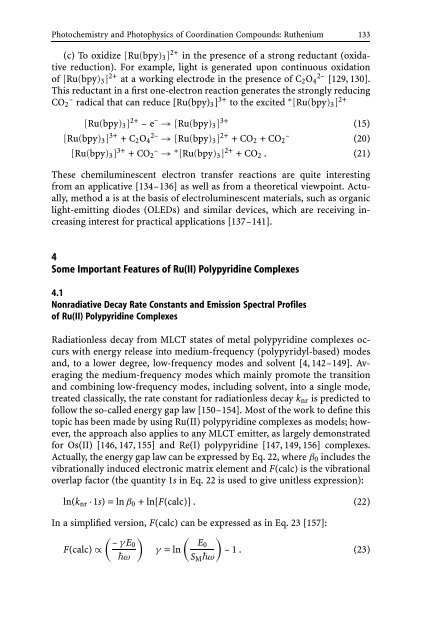Photochemistry and Photophysics of Coordination Compounds
Photochemistry and Photophysics of Coordination Compounds
Photochemistry and Photophysics of Coordination Compounds
You also want an ePaper? Increase the reach of your titles
YUMPU automatically turns print PDFs into web optimized ePapers that Google loves.
<strong>Photochemistry</strong> <strong>and</strong> <strong>Photophysics</strong> <strong>of</strong> <strong>Coordination</strong> <strong>Compounds</strong>: Ruthenium 133<br />
(c) To oxidize [Ru(bpy)3] 2+ in the presence <strong>of</strong> a strong reductant (oxidative<br />
reduction). For example, light is generated upon continuous oxidation<br />
<strong>of</strong> [Ru(bpy)3] 2+ at a working electrode in the presence <strong>of</strong> C2O4 2– [129, 130].<br />
This reductant in a first one-electron reaction generates the strongly reducing<br />
CO2 – radical that can reduce [Ru(bpy)3] 3+ to the excited ∗ [Ru(bpy)3] 2+<br />
[Ru(bpy)3] 2+ –e – → [Ru(bpy)3] 3+ (15)<br />
[Ru(bpy)3] 3+ +C2O4 2– → [Ru(bpy)3] 2+ +CO2 +CO2 – (20)<br />
[Ru(bpy)3] 3+ +CO2 – → ∗ [Ru(bpy)3] 2+ +CO2 . (21)<br />
These chemiluminescent electron transfer reactions are quite interesting<br />
from an applicative [134–136] as well as from a theoretical viewpoint. Actually,<br />
method a is at the basis <strong>of</strong> electroluminescent materials, such as organic<br />
light-emitting diodes (OLEDs) <strong>and</strong> similar devices, which are receiving increasing<br />
interest for practical applications [137–141].<br />
4<br />
Some Important Features <strong>of</strong> Ru(II) Polypyridine Complexes<br />
4.1<br />
Nonradiative Decay Rate Constants <strong>and</strong> Emission Spectral Pr<strong>of</strong>iles<br />
<strong>of</strong> Ru(II) Polypyridine Complexes<br />
Radiationless decay from MLCT states <strong>of</strong> metal polypyridine complexes occurs<br />
with energy release into medium-frequency (polypyridyl-based) modes<br />
<strong>and</strong>, to a lower degree, low-frequency modes <strong>and</strong> solvent [4, 142–149]. Averaging<br />
the medium-frequency modes which mainly promote the transition<br />
<strong>and</strong> combining low-frequency modes, including solvent, into a single mode,<br />
treated classically, the rate constant for radiationless decay knr is predicted to<br />
follow the so-called energy gap law [150–154]. Most <strong>of</strong> the work to define this<br />
topic has been made by using Ru(II) polypyridine complexes as models; however,<br />
the approach also applies to any MLCT emitter, as largely demonstrated<br />
for Os(II) [146, 147, 155] <strong>and</strong> Re(I) polypyridine [147, 149, 156] complexes.<br />
Actually, the energy gap law can be expressed by Eq. 22, where β0 includes the<br />
vibrationally induced electronic matrix element <strong>and</strong> F(calc) is the vibrational<br />
overlap factor (the quantity 1s in Eq. 22 is used to give unitless expression):<br />
ln(knr · 1s)=lnβ0 +ln[F(calc)] . (22)<br />
In a simplified version, F(calc) can be expressed as in Eq. 23 [157]:<br />
� �<br />
– γ E0<br />
F(calc) ∝<br />
�ω<br />
� �<br />
E0<br />
γ =ln –1.<br />
SM�ω<br />
(23)

















